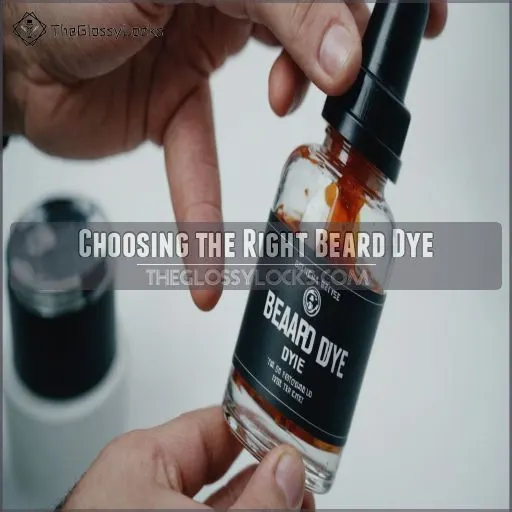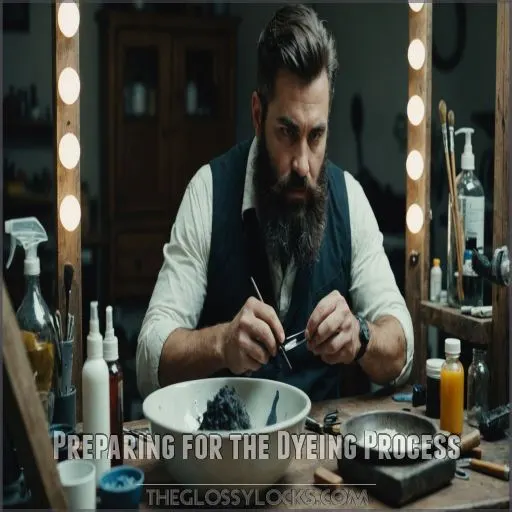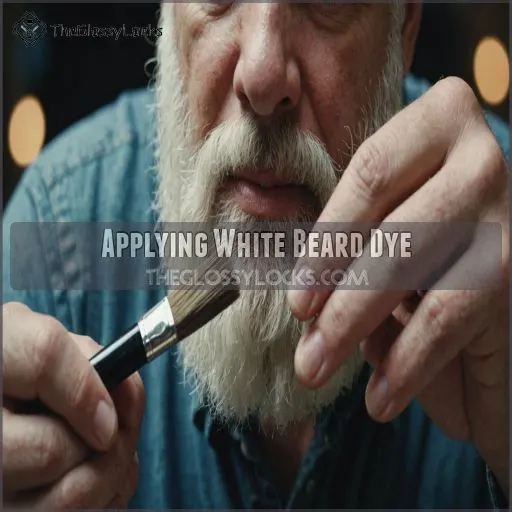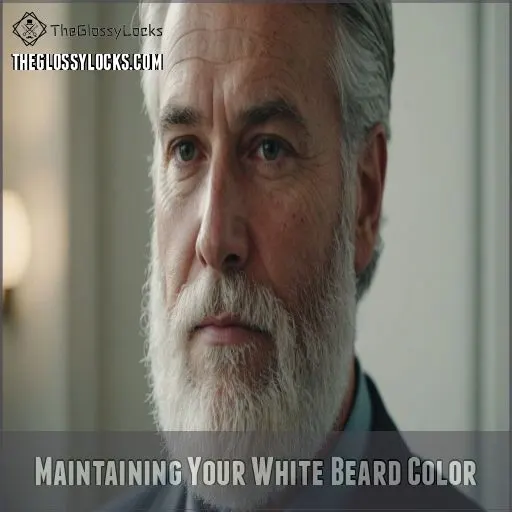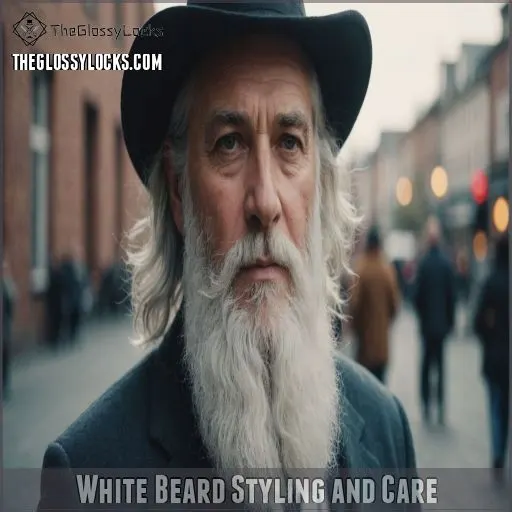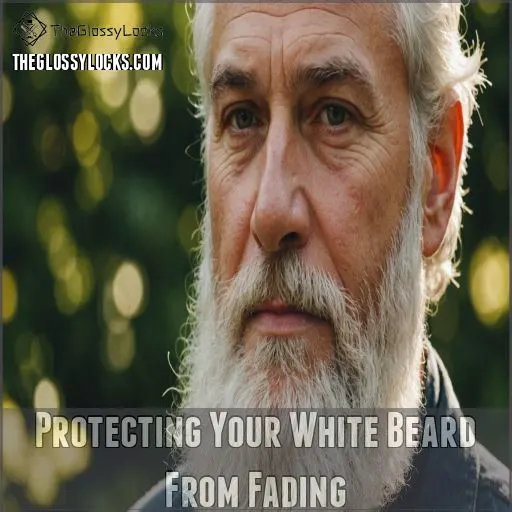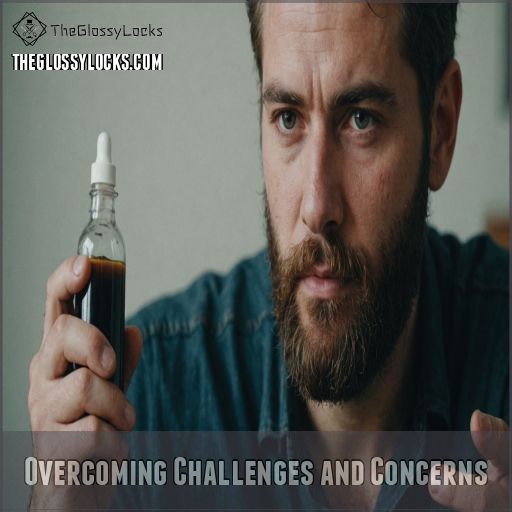This site is supported by our readers. We may earn a commission, at no cost to you, if you purchase through links.
 You’re ready to dye your beard white and transform into the wise sage of your dreams!
You’re ready to dye your beard white and transform into the wise sage of your dreams!
First, choose if you want the temporary thrill or the permanent deal.
Prepare your supplies—gloves, brush, and Vaseline to keep your skin unstained.
Don’t skip the allergy test, unless you love surprises.
Mix your dye, then apply it evenly, like frosting on a cake.
After giving it some time, rinse with lukewarm water to lock that color in.
Maintain that snowy glory with gentle products.
Embrace the change and keep an eye out for expert styling tips that’ll keep your new look sharp, like choosing the right beard style.
Table Of Contents
- Key Takeaways
- Choosing the Right Beard Dye
- Preparing for the Dyeing Process
- Applying White Beard Dye
- Maintaining Your White Beard Color
- Managing Skin and Hair Damage
- White Beard Styling and Care
- Protecting Your White Beard From Fading
- Overcoming Challenges and Concerns
- Frequently Asked Questions (FAQs)
- Conclusion
Key Takeaways
- Choose Your Commitment Level: Deciding between temporary or permanent beard dye is like picking between a weekend getaway and a year-long adventure. Temporary dye gives you the thrill without the strings, while permanent dye locks in the color but needs a longer commitment. Consider what suits your style and budget best.
- Stock Up on Supplies: Before you start turning your beard into a snowy masterpiece, gather essentials like gloves, a brush, and Vaseline. Picture Vaseline as your trusty sidekick, keeping the dye off your skin and letting you focus on the main event—the beard transformation itself!
- Mastering the Dye Process: Mixing and applying beard dye is an art. Follow the instructions like a pro baker, ensuring even coverage from roots to tips. Timing is key, so don’t rush—let the dye work its magic, then rinse with lukewarm water to seal in that wintry hue.
- Maintain Your New Look: Keeping your white beard vibrant is a bit like nurturing a delicate plant—use gentle shampoos, ditch harsh chemicals, and protect it from the sun. Regular touch-ups will keep your beard looking crisp and fresh, warding off any dreaded yellow tones.
Choosing the Right Beard Dye
If you’re thinking about dyeing your beard white, you’ll need to decide between temporary and permanent options.
Each type has its own advantages and drawbacks, so consider your skin sensitivity, desired commitment level, and budget to choose the right beard dye for your needs.
Temporary Vs. Permanent Beard Dyes
Choosing between temporary and permanent beard dyes is like picking between a weekend fling or a long-term relationship. Temporary hair dye offers less commitment but fades quickly. Permanent options promise lasting color but need more maintenance.
- Cost: Temporary is cheaper up-front.
- Application: Easier with temporary.
- Maintenance: Frequent with temporary.
- Fade: Permanent lasts longer.
Factors to Consider for Your Skin and Hair Type
When dyeing your beard white, consider your skin sensitivity, hair texture, and beard thickness. Remember, one man’s treasure beard dye might be another man’s disaster. Here’s a quick guide:
| Factor | Impact | Consideration |
|---|---|---|
| Skin Sensitivity | Possible irritation | Do a patch test |
| Hair Texture | Dye absorption rate | Choose suitable formula |
| Beard Thickness | Coverage needs | Opt for rich dye |
| Color Matching | Realistic results | Blend with natural hair color |
Choose wisely!
Differences in Cost and Maintenance
Life’s full of choices, like temporary or permanent beard dye. Temporary options let you change your look without a lifetime commitment, while permanent dyes mean fewer touch-ups.
- Product Price: Temporary is usually cheaper.
- Dye Frequency: Permanent means less hassle.
- Salon Vs. DIY: DIY can save bucks, but salons offer expertise.
Preparing for the Dyeing Process
Before you start dyeing your beard white, make sure you have the right supplies on hand – gloves, a brush or comb, an old towel, and some Vaseline.
It’s also a good idea to do an allergy test first to make sure your skin doesn’t react to the dye ingredients.
Gathering Necessary Supplies (gloves, Brush/comb, Old Towel, Vaseline)
You’ve picked the perfect beard dye, now gather your essentials: sturdy gloves, a trusty brush or comb, and an old towel you won’t miss for a good patch test.
A jar of Vaseline is like your magic shield, protecting your skin from those pesky dye streaks. Imagine it as your personal bodyguard – one who’s battle-ready against stains and rogue splashes.
Protecting Your Skin and Clothing From Stains
Arm yourself against dye-stained clothes and chaos. Create a fortress with these steps:
- Layer old towels over surfaces for a dye-free area.
- Wear clothes made from stain-resistant fabric.
- Apply Vaseline as a protective barrier around your beard’s edges.
- Consider gloves to keep hands dye-free.
Allergy Tests for Sensitivity to Dye Ingredients
Let’s dodge any dye disasters.
Protecting skin is just the warm-up act.
Ever wondered if dye ingredients will make your skin throw a tantrum?
Do a patch test:
| Step | Details |
|---|---|
| 1. Pick Spot | Inner arm or behind the ear |
| 2. Apply Dye | Use a small amount, let dry |
| 3. Wait | 24-48 hours for any skin reactions |
| 4. Check | Look for itchiness or redness |
Ah, peace of mind!
Applying White Beard Dye
Dyeing your beard white is a transformative process that requires careful attention to detail.
Mix the dye according to the instructions, then apply it evenly from the roots to the ends, allowing the recommended time for the desired results before rinsing and shampooing thoroughly.
Mixing the Dye According to Instructions
When it’s time to mix up your beard dye, think of it like baking a cake—precision is key.
Use the proper tools and follow dye ratio instructions with care.
Mix until you achieve color consistency.
For safety, wear gloves to protect skin.
Applying the Dye Evenly From Roots to Ends
So, you’ve mixed your dye, and it’s go time! Make sure your application game is on point for that even, vibrant color from roots to ends.
- Section your beard.
- Use a brush for even coverage.
- Focus on those roots.
- Check color consistency.
Recommended Dyeing Time for Desired Results
For your dream white beard, timing’s everything!
Dyeing frequency depends on color intensity and beard thickness.
Thick beards might need up to two hours, while finer ones less.
Aim for a cool vibe and texture by considering your hair type and desired shade.
Rinsing and Shampooing After Dyeing
Thoroughly rinse out the dye, ensuring no residue remains. Then, use a gentle, sulfate-free shampoo to cleanse your freshly dyed beard. This will help lock in the color and prevent premature fading. Avoid hot water, which can strip the dye.
- Rinse thoroughly to remove all dye
- Use a gentle, sulfate-free shampoo
- Avoid hot water to prevent color fading
Maintaining Your White Beard Color
Maintaining your white beard’s color can feel like keeping a snowman from melting in summer, but don’t worry, it’s easier than it seems.
By using gentle shampoos and avoiding harsh chemicals, you’ll keep your beard as bright as a winter morning, and remember, regular touch-ups are your secret weapon against dullness.
Using Gentle Shampoos and Conditioners
Once you’ve rocked that beard dye, keeping your white beard fresh means embracing gentle cleansing.
Opt for sulfate-free shampoos and conditioners to avoid stripping away color.
Try conditioner washing with moisturizing ingredients—your beard will thank you.
And remember, a little beard oil benefits those bristles, keeping them soft as a cloud on a breezy day!
Avoiding Harsh Chemicals and Excessive Heat Styling
Keep that white beard glowing by sticking to natural beard care.
Swap harsh chemicals for gentle beard products—it’s the little things that make a big difference.
And remember, your beard’s a delicate thing; excessive heat’s its arch nemesis!
Embrace heatless styling and focus on hair health tips for fabulous color protection.
Your beard deserves it!
Touch-Up Frequency for Maintaining Desired Color
Your white beard won’t stay pristine forever – expect the color to fade over time. Touch up the dye every 4-6 weeks to keep it looking its best.
Consider these tips:
- Use a color-depositing shampoo to extend the life of your dye
- Avoid excessive sun exposure, which can cause rapid fading
- Embrace the gradual shift in tone – a little grow-out can add character
- Schedule regular touch-ups with your colorist for a smooth change
Managing Skin and Hair Damage
Dyeing your beard white can feel like taming a wild beast—exciting but requiring caution to avoid skin irritation and damage.
Don’t worry, keeping skin itch-free and your beard luscious isn’t rocket science; it’s all about the right care habits for sensitive skin!
Risks of Skin Irritation and Allergic Reactions
Dye allergies can be a real pain in the beard! If you’ve got sensitive skin, it’s wise to do a patch test. Avoid chemicals that could turn your face into a tomato. Natural remedies might save the day. Here’s a quick look at the risks:
| Risk | Symptoms | Remedy |
|---|---|---|
| Allergy | Redness, itching | Antihistamines |
| Sensitivity | Swelling, burning | Aloe Vera gel |
| Irritation | Rashes | Cold compress |
| Chemical Burns | Blisters | Seek medical care |
Patch test and natural remedies are helpful in preventing and treating dye allergies. Avoid chemicals that could irritate your skin.
Hair Follicle Damage From Frequent Dyeing
Hair follicle damage from frequent dyeing is like too much sun—good at first, but not so nice later. Avoid dye-related thinning and keep your follicle health strong as an ox by remembering:
- Give hair growth cycles a breather.
- Don’t go overboard with bleach.
- Avoid harsh chemicals.
- Treat damaged hair repairs seriously.
Using Nourishing Products to Prevent Dryness and Breakage
Don’t let dryness and breakage cramp your white beard’s style.
Nourish it with a co-washing routine using a creamy Utility Softener – it’ll hydrate and strengthen each strand.
Finish with a few drops of Utility Oil to replicate natural sebum and Utility Balm to seal in moisture.
Your beard will be soft, supple, and oh-so-suave.
White Beard Styling and Care
Styling your white beard is like choosing a perfect movie; go too long, and you might look like a wizard, but too short, and you’re missing the magic. Keep it balanced and shaped to add an intriguing touch to your dashing look.
Ideal Length for a White Beard
Feeling the urge to conquer the white beard look? Well, consider this: the ideal length is 2-6 inches. Not too long, not too short, Goldilocks-approved!
- A 2-inch beard offers low-maintenance charm.
- Go 4 inches for a bit of majestic wisdom.
- Six inches? Now you’re channeling wizard vibes!
Choose wisely, brave soul! 慄♂️
Shaping and Trimming for a Balanced Look
Finding that perfect beard length is just the tip of the iceberg.
Next, let’s talk shaping and trimming for a balanced look.
Grab quality beard trimming tools and consider your face shape; it’s important for matching the right style.
Embrace current beard shape trends by following a reliable beard style guide.
Your white beard’s upkeep transforms into self-expression!
Avoiding Unflattering Lengths and Styles
Steer clear of extremes – an overly long white beard can veer into Santa or wizard territory, while a super-short style may accentuate an already round face.
Aim for 2-6 inches to strike the perfect balance, complementing your facial structure.
Embrace sharp lines to counteract age-related softening.
Protecting Your White Beard From Fading
To keep your white beard looking fresh and vibrant, protect it from turning yellow or dull over time.
Use purple shampoo to tackle any yellowing, skip products with sulfates and silicones, and give your beard a break from too much sun—unless you want it to have a brighter future than your last vacation!
Using Purple Shampoo to Neutralize Yellowing
A well-shaped white beard indeed looks grand, but yellow tones can rain on your parade.
Enter purple shampoo—the superhero of color correction! It neutralizes yellowing, restoring your beard’s bright glory.
Integrating it weekly brightens up your mane while keeping a handle on unwanted hues.
Look for the best purple shampoos to enhance this process.
Avoiding Sulfates and Silicones in Hair Products
While keeping your white beard bright with purple shampoo, ditch sulfates and silicones to protect it from fading.
These hair product myths can fool you; instead, embrace:
- Sulfate-free shampoo benefits: Gentle on color.
- Silicone alternatives: Maintain hair’s healthy shine.
- Product ingredient lists: Your new best friend for healthy hair tips!
Who knew simplicity could hold so much power?
Reducing Sun Exposure to Prevent Color Fading
Protect your freshly dyed white beard from the sun’s harsh rays.
Sun-sensitive dyes require extra TLC to maintain their pristine appearance.
Slip on a sun-protective hat when heading outdoors, and apply a UV-blocking beard oil or SPF-infused balm to shield your delicate strands.
Seek shade whenever possible – your vibrant white hue will thank you.
| Sun Protection Tips | ||||
|---|---|---|---|---|
| Wear a Sun Hat | Use UV-Blocking Beard Oil | Seek Shady Spots | Apply SPF Beard Balm | Avoid Direct Sunlight |
Overcoming Challenges and Concerns
Sure, keeping your beard snowy white comes with its twists and turns.
From combating premature graying to embracing the quirks of upkeeping a white beard, you’ll need the patience of a wizard and the resourcefulness of an artist.
Addressing Premature Graying and Hair Loss
Tackling premature graying can feel like herding cats, but it’s all about genetics, stress, and lifestyle.
Stress less and embrace a balanced routine, brimming with nutrients and rest.
Consider hair loss products if things go south, but remember, white beards spell wisdom and charm!
Consult a pro if medical conditions are affecting your mane.
Managing White Beard Maintenance and Upkeep
Keeping your white beard looking sharp and vibrant is all about the right routine!
Use white beard products like a nourishing beard oil; its benefits include preventing dryness and enriching the color.
Establish a beard grooming routine with regular trims to maintain your desired style.
Embracing the Unique Challenges of a White Beard
Embrace the unique charm of your white beard with confidence!
Rocking this distinguished look takes some extra care, but the payoff is a sophisticated, timeless style.
Lean into the wisdom it exudes and own your graying glory.
After all, white beards are a trending style – so flaunt it with pride!
Frequently Asked Questions (FAQs)
Is it possible to dye your beard white?
You bet your whiskers, dyeing your beard white is totally doable!
With the right know-how and a steady hand, you can transform your look and channel your inner silver fox.
Just take it one step at a time, and you’ll be rocking that pristine beard in no time.
How to whiten your beard?
Start by bleaching your beard if it’s dark, then apply white hair dye evenly.
Don gloves and protect skin with Vaseline.
Follow instructions closely for vibrant results.
Keep that beard healthy and bright with purple shampoo.
Is it safe to bleach your beard?
Bleaching your beard can work wonders, turning it into a canvas for bold styles.
But tread carefully—your skin might protest with irritation or allergies.
Always do a patch test and consider consulting a pro for safety.
How do I keep my beard white?
Keep your beard white by using gentle shampoos and conditioners—hot water’s a no-no!
Use purple shampoo to prevent yellowing, and protect it from the sun.
Regular touch-ups will keep that snowy look fresh as a daisy.
How does diet affect beard health?
Your diet plays a major role in beard health.
Eating nutrient-rich foods like leafy greens, lean proteins, and healthy fats nourish follicles, promote growth, and keep your beard looking its best.
Don’t skimp on the vitamins – your beard will thank you!
Can white beard dye cause allergies?
Surprisingly, that coveted white beard can come with a catch—potential allergies!
Maybe you’ll discover itchy skin or a fiery redness as dyes sometimes trigger allergic reactions.
So, always perform a patch test to avoid unexpected drama.
What are natural alternatives to dye?
Try natural alternatives like henna or chamomile tea for a subtle tint.
These methods let you embrace your unique look without harsh chemicals.
Is temporary dye easy to remove?
Temporary dye‘s like an adventure—you can enjoy it and easily remove it!
Use clarifying shampoo or natural remedies like baking soda and vinegar, and you’ll reset your beard’s color and story in no time.
Will dye damage beard texture?
Dyeing your beard can indeed impact its texture, but with the right products and techniques, you can keep it soft and manageable.
Just be gentle, use moisturizing conditioners, and avoid over-processing to maintain that luxurious white beard.
Conclusion
Picture your beard as a blank canvas, ready to be transformed into a snowy masterpiece.
You’ve now got the knowledge on how to dye your beard white and maintain its brilliance.
From choosing the right dye to trimming for the perfect balance, your journey is well underway.
Remember, it’s not just about changing color; it’s about embracing a new style.
So go ahead, jump into this exciting venture, and let your distinguished look inspire confidence and individuality.

